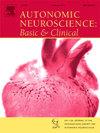Cardiovascular and neuroimmune adaptations to enalapril and exercise training: A comparative study in male and ovariectomized female spontaneously hypertensive rats
IF 3.3
4区 医学
Q2 NEUROSCIENCES
引用次数: 0
Abstract
Antihypertensive drug and exercise training are commonly prescribed to treat arterial hypertension. However, there is a considerable gap in understanding how physiological mechanisms of male and female adapt to the combination of these approaches. Therefore, we focused to investigate sexual differences in cardiovascular, autonomic, inflammation and systemic oxidative stress adaptations in male and OVX female ovariectomized spontaneously hypertensive rats (SHR) treated with enalapril associated with moderate-intensity concurrent exercise training. Enalapril (3 mg/kg, diluted in drinking water) and exercise training (3 days/week, moderate intensity) was carried out for 8 weeks. Blood pressure (BP), heart rate (HR) and its variabilities were assessed. Serum and plasma were used for inflammatory and oxidative stress analyses. Enalapril, associated or not with exercise training, induced a reduction in diastolic and mean BP in both sexes; however, only the OVX female groups showed a reduction in systolic BP, as well as resting bradycardia. Both sexes showed improvements in BP and HR variability following the treatments; however, improvement in SD2/SD1 ratio, which indicates how much the heartbeats occur at irregular intervals, and in variance of systolic BP were observed only in trained groups. A higher spontaneous baroreflex sensitivity, as well as reduced IL-6/IL-10 were found only in the trained groups. Increased IL-10 was observed in male trained group (vs. other groups). Finally, combination enalapril and exercise training reduced systemic pro-oxidants such as NADPH oxidase and hydrogen peroxide. The findings of our study showed that OVX female SHR, after ovarian hormone deprivation, presented more pronounced effects on hemodynamics, BP variability, and anti-inflammatory profile than hypertensive males with the combination of treatments.
Background
Researchers are investigating how the body responds differently in males and females. These differences are also evident when examining how pharmacological and non-pharmacological approaches help the body control arterial hypertension. This study aimed to investigate how drug medication combined with exercise affects the heart's ability to self-regulate and how it relates to immune and oxidant defense, with a focus on differences in male and ovariectomized (OVX) female adaptations.
Methods
The study was conducted using hypertensive male and OVX female rats, allocated into: a) sedentary, b) enalapril, or c) enalapril plus exercise groups, totaling six groups (3 males and 3 OVX females, respectively). Enalapril (3 mg/kg/day) and exercise (aerobic and resistance exercises) were prescribed for eight weeks. The effects on blood pressure control, serum, and plasma were assessed.
Results
Although both males and OVX females showed improvements in blood pressure after medication, combined or not with exercise, OVX females had better control of blood pressure and heart rhythm regulation. Furthermore, including an exercise program during medication treatment improved immune defense in OVX females only, as well as the levels of key enzymes involved in the process of organ damage development in both sexes.
Conclusion
OVX female rats benefited more from the combination of medication and exercise compared to male rats. This suggests that OVX females may experience additional health benefits from the combination of antihypertensive approaches, highlighting the importance of understanding how exercise impacts the body differently in males and OVX females, which could contribute to better long-term disease management.
依那普利和运动训练对心血管和神经免疫的适应性:雄性和去卵巢雌性自发性高血压大鼠的比较研究
抗高血压药物和运动训练是治疗动脉高血压的常用方法。然而,在了解男性和女性的生理机制如何适应这些方法的组合方面还存在相当大的差距。因此,我们重点研究了雄性和卵巢切除的雌性自发性高血压大鼠(SHR)在服用依那普利并同时进行中等强度的运动训练后,在心血管、自主神经、炎症和全身氧化应激适应性方面的性别差异。依那普利(3 毫克/千克,稀释在饮用水中)和运动训练(3 天/周,中等强度)共进行了 8 周。对血压(BP)、心率(HR)及其变异性进行了评估。血清和血浆用于炎症和氧化应激分析。无论是否与运动训练结合,依那普利都能降低男女双方的舒张压和平均血压;然而,只有卵巢切除女性组的收缩压和静息心动过缓有所降低。治疗后,男女两性的血压和心率变异性都有所改善;然而,只有受过训练的组别在 SD2/SD1 比值(表示心脏跳动间隔不规则的程度)和收缩压变异性方面有所改善。只有在训练组中才发现自发气压反射灵敏度提高,IL-6/IL-10 降低。在男性训练组(与其他组相比)观察到 IL-10 增加。最后,联合使用依那普利和运动训练可减少全身促氧化剂,如 NADPH 氧化酶和过氧化氢。我们的研究结果表明,OVX 雌性 SHR 在卵巢激素剥夺后,与高血压雄性相比,联合治疗对血液动力学、血压变异性和抗炎特征的影响更明显。在研究药物疗法和非药物疗法如何帮助人体控制动脉高血压时,这些差异也很明显。本研究旨在探讨药物治疗与运动相结合如何影响心脏的自我调节能力,以及它与免疫和氧化物防御的关系,重点是雄性和卵巢切除(OVX)雌性适应性的差异。方法本研究使用高血压雄性大鼠和卵巢切除雌性大鼠,将它们分为:a)静坐组;b)依那普利组;或c)依那普利加运动组,共六组(分别为 3 只雄性和 3 只卵巢切除雌性大鼠)。依那普利(3 毫克/千克/天)和运动(有氧运动和阻力运动)用药八周。结果虽然男性和卵巢切除女性在用药后血压都有所改善,但无论是否结合运动,卵巢切除女性的血压控制和心律调节都更好。结论与雄性大鼠相比,OVX 雌性大鼠从药物和运动的结合中获益更多。这表明OVX雌性大鼠可能会从联合降压方法中获得额外的健康益处,突出了了解运动如何对雄性和OVX雌性大鼠的身体产生不同影响的重要性,这将有助于更好地进行长期疾病管理。
本文章由计算机程序翻译,如有差异,请以英文原文为准。
求助全文
约1分钟内获得全文
求助全文
来源期刊
CiteScore
5.80
自引率
7.40%
发文量
83
审稿时长
66 days
期刊介绍:
This is an international journal with broad coverage of all aspects of the autonomic nervous system in man and animals. The main areas of interest include the innervation of blood vessels and viscera, autonomic ganglia, efferent and afferent autonomic pathways, and autonomic nuclei and pathways in the central nervous system.
The Editors will consider papers that deal with any aspect of the autonomic nervous system, including structure, physiology, pharmacology, biochemistry, development, evolution, ageing, behavioural aspects, integrative role and influence on emotional and physical states of the body. Interdisciplinary studies will be encouraged. Studies dealing with human pathology will be also welcome.

 求助内容:
求助内容: 应助结果提醒方式:
应助结果提醒方式:


